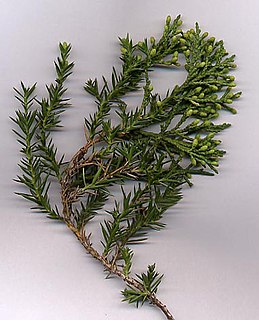
Juniperus chinensis, the Chinese juniper is a species of plant in the cypress family Cupressaceae, native to China, Taiwan, Myanmar, Japan, Korea and the Russian Far East. Growing 1–20 m (3.3–65.6 ft) tall, it is a very variable coniferous evergreen tree or shrub,

Celosia argentea, commonly known as the plumed cockscomb or silver cock's comb, is a herbaceous plant of tropical origin, and is known for its very bright colors. In India and China it is known as a troublesome weed.
Banksia plumosa is a species of shrub that is endemic to Western Australia. It has hairy stems, broadly linear pinnatifid to pinnatipartite leaves with triangular lobes, creamy-yellow flowers in heads of up to eighty, and egg-shaped follicles.

Alex George's taxonomic arrangement of Dryandra was the first modern-day arrangement of that taxon. First published in Nuytsia in 1996, it superseded the arrangement of George Bentham, which had stood for over a hundred years; it would later form the basis for George's 1999 treatment of Dryandra for the Flora of Australia. In accordance with contemporary thinking, George treated Dryandra as a genus, dividing it into three subgenera, the largest of which was divided into 24 series. The arrangement stood until 2007, when Dryandra was transferred into Banksia as B. ser. Dryandra. No alternative has yet been proposed.
Robert Brown's taxonomic arrangement of Dryandra was the first arrangement of what is now Banksia ser. Dryandra. His initial arrangement was published in 1810, and a further arrangement, including an infrageneric classification, followed in 1830. Aspects of Brown's arrangements can be recognised in the later arrangements of George Bentham and Alex George.

Libocedrus plumosa, with the common name kawaka, is a species of Libocedrus that is endemic to New Zealand.

Verticordia plumosa, commonly known as plumed featherflower, is a flowering plant in the myrtle family, Myrtaceae and is endemic to the south-west of Western Australia. It was the first species in the genus to be described, although initially given the name Chamelaucium plumosum. It is a shrub with linear leaves and rounded groups of scented pink, mauve or white flowers. Two varieties of this species have been declared as being "threatened".

Diduga is a genus of moths in the family Erebidae.
Banksia plumosa subsp. plumosa is a subspecies of Banksia plumosa. As an autonym, it is defined as encompassing the type material of the species. It was known as Dryandra plumosa subsp. plumosa until 2007, when Austin Mast and Kevin Thiele sunk all Dryandra into Banksia. As with other members of Banksia ser. Dryandra, it is endemic to the South West Botanical Province of Western Australia.

Dryandra subg. Dryandra is an obsolete clade of plant. It was a series within the former genus Dryandra. The name was first published at sectional rank as Dryandra verae in 1830, before being renamed Eudryandra in 1847, the replaced by the autonym at subgenus rank in 1996. It was ultimately discarded in 2007 when Austin Mast and Kevin Thiele sunk Dryandra into Banksia.
Dryandra ser. Plumosae is an obsolete series within the former genus Dryandra. It was published by Alex George in 1996, but discarded in 2007 when Austin Mast and Kevin Thiele sank Dryandra into Banksia.

Norape is a genus of moths in the family Megalopygidae. The genus was erected by Francis Walker in 1855.
Diduga excisa is a moth of the family Erebidae. It is found in the Philippines.

Diduga flavicostata is a moth of the family Erebidae first described by Snellen in 1879. It is found on Java, as well as in Australia, India, Sri Lanka, Myanmar, Malaysia, China and Japan.
Diduga haematomiformis is a moth of the family Erebidae. It is found on Java.
Diduga metaleuca is a moth of the family Erebidae. It is found in the Philippines.
The Nudariina are a subtribe of lichen moths in the family Erebidae. The taxon was described by Carl Julius Bernhard Börner in 1920.
Acropora plumosa is a species of acroporid coral that was first described by Dr. C. C. Wallace and J. Wolstenholme in 1998. Found in marine, tropical, reefs on slopes sheltered from wave action, and on reef walls. It occurs at depths between 10 and 30 m. It is classed as a vulnerable species on the IUCN Red List, and it has a decreasing population. It is not common and found over a large area and is classified under CITES Appendix II.
Norape plumosa is a moth of the Megalopygidae family. It was described by Arthur Gardiner Butler in 1877. It is found in Costa Rica, Panama and the Amazon region.

Petrophile plumosa is a species of flowering plant in the family Proteaceae and is endemic to southwestern Western Australia. It is a shrub with rigid, sharply-pointed, sometimes lobed leaves, and more or less spherical heads of hairy, pale yellow flowers.









